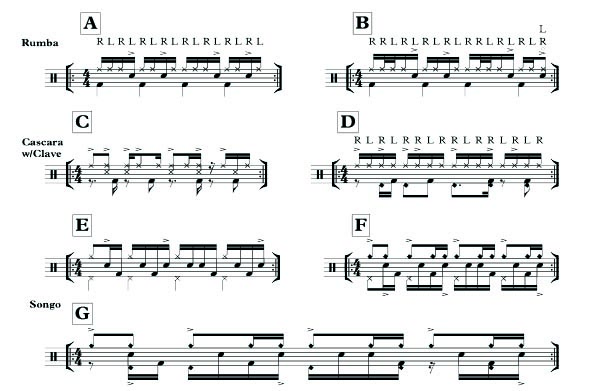Since we don’t have ten years up our sleeves to do countless gigs and learn these grooves gradually, I thought I’d share some ‘extended’ versions of the three main Cuban grooves that I’ve had to play on the Salsa gigs I’ve done. These, by far, get used the most and depending on the instrumentation in the band, will somewhat dictate, on what you are required or allowed to play. Each of these grooves is an adaptation from the combined percussion instrumentation variant – something to be mindful of when approaching the music.
Rumba
Rumba is a popular Afro-Cuban groove and is categorised on the drums by a syncopated snare drum part and a four-on-the-floor bass drum part (FIG A). You approach the groove using 16th notes on the hi-hat with both hands – disco style. The hands move to the snare drum as required. The right hand handles the down beats and the left hand, the off beats. The extended version (FIG B) of the Rumba adds a couple of little embellishments like 32nd note ruffs and an open hi-hat on the last snare. This involves having to play a left hand stroke on the downbeat at the end of the phrase. This is probably the easiest of our trio of grooves, but that left hand can catch you out.
Cascara With Clave
This is the groove for the verse of a Salsa tune (FIG C), and there are a few ways to play this standard version. The whole groove is based around a ‘Clave Pattern’. Without going into too much detail, this pattern (playing on the rim of the snare drum using the left hand) can be halved and reversed. In other words, beats 1 and 2 become 3 and 4 and vice versa which moves all the parts. The right hand Cascara pattern – traditionally played on the side of the timbale, is a highly syncopated phrase, played with accents on the hi-hat or the side of the floor tom. The bass drum part is noted as the bombo note – traditionally played on the final semiquaver of beat 1 and 3, but often interpreted as the full pattern you see in Figure C and follows the bass guitar. This initial groove needs to be really comfortable before attempting the extended version. Getting a little more involved (FIG D), our Cascara pattern now has the left hand on the hi-hat, filling in the gaps in the existing pattern as soft strokes or ghost notes. This creates a very heavy 16th note pulse with accents. The Bombo note bass drum pattern remains but crucially, the clave pattern (no longer available for the left hand) is moved to the left foot. This is often achieved with another bass drum pedal attached to a cowbell. The tricky bit (apart from the more difficult independence) is keeping the hi-hat closed with the toes of the left foot and operating another pedal with the heel. The only way to avoid this is to create other sounds (extra set of hi-hats or a set of timbales).
Songo
The Songo (FIG E) is the only groove created for the drumset by master timbale player Chanquito. However, it does utilise some of the key elements from the Cascara groove such as the clave and bass drum in the extended versions. Like the Cascara pattern, the whole groove can be halved and reversed. The basic version is a true, linear groove. Nothing overlaps, the right hand plays crotchets on the ride or hi-hat, the bass drums plays the bombo pattern and the left hand employs a combination of accents and ghost notes. This basic pattern works perfectly in the chorus of a salsa tune and ‘_ts’ around the other percussion instruments. In Figure F, you can add crotchets stepped in the hi-hat as well as a strong cowbell pattern that employs very heavy, accented crotchet notes on the mouth of the cowbell and the offbeats on the tip. This pattern is often played with a hand-held bell. The left hand remains the same as the original pattern. The final, and perhaps hardest pattern (FIG G), is identical to figure F but puts the clave in the left foot as before. This changes the ball game in terms of independence but makes for a very cool groove. It’s important to remember that these groove cover percussion parts so if they’re already being played, you don’t have to. This means that you might have to vary the groove but if the patterns are not being covered, go for gold!

